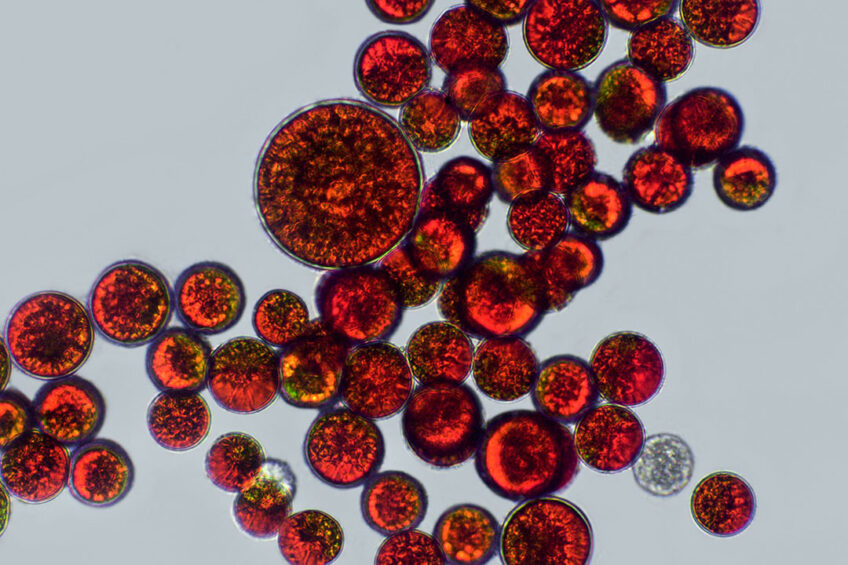Microalgae: A sustainable food source for fish

Feed represents 50-70% of fish farming production costs, and the average price of ingredients commonly used in fish feed is constantly rising. Thus finding alternatives, that are sustainable, inexpensive and easy to manufacture is essential. This article will discuss microalgae and their nutritional composition, the impact on fish, and current challenges.
Fishmeal is the most common commercial product obtained from the small fish or fish waste to feed farmed fish. In intensive or semi-intensive fish farming, proper protein supplementation and feed cost are important factors to consider. In addition, fish farmers need to find a balance between rapid fish growth and the most efficient use of available feed. Therefore, it is important to find an alternative sustainable food source that is inexpensive and easy to manufacture. Microalgae is a promising alternative food source in the production of fishmeal which improves the nutritional value of aquaculture feed and reduces the pressure on fish and fish oil.
What are microalgae?
Algae are photosynthetic creatures providing cellular carbon and chemical energy to other organisms. Microalgae are microscopic algae invisible to naked eye with a capacity to offer various green chemicals. They are rich in lipids, proteins, and carbohydrates, with economic and environmental benefits. And represent an untapped resource with massive biodiversity. The chemical composition of microalgae varies based on species and cultivation conditions.
Microalgae nutritional components
The nutritional composition of microalgae includes fatty acids, protein, and carbohydrates which are affected by environmental factors, such as pH value, light intensity, nutrient, CO2 supply, temperature value, and mixing.
Microalgae is a proper alternative compound rich in unsaturated fatty acids to replace fish oils in fishmeal. Microalgal lipids have a slightly higher concentration of omega-3 fatty acids such as EPA and DHA as well as less chemical contamination compared to fish oil. In addition, microalgae produce valuable essential fatty acids such as alpha-linolenic acid, gamma-linolenic acid, linoleic acid, and arachidonic acid that can be utilised in food industry. Microalgae can be metabolically or genetically engineered to produce various protein products. They contain up to 70% protein and are an inexpensive alternative protein source with balanced protein profile. Plus microalgae are considered a significant source of vitamins B12, E, and C. Carbohydrates such as cellulose, sugars, starch, and other polysaccharides serve as an energy storage reserve, and structural components in the cell walls, and they are present in both the cytosol and inside the chloroplast of microalgae.
Effects of feeding microalgae
Small fish species such as flounders, halibut, seabass, Atlantic cod, seabream, and striped mullet are nourished by some species of microalgae in hatcheries. Haematococcus pluvialis is a microalgae species rich in astaxanthin, a red pigment that belongs to a group of chemicals called carotenoids, that makes a pink colour to salmon fish and improves the nutrient profile of fish. Dunaliella salina is the main source of natural β-carotene used as a colour for the seafood-market to approve the pigment value and marketing. Pavlova species and Nannochloropsis species enhance omega-3 fatty acids in fish, clams, mussels, oysters, and brood stock. Salmon fed the mineral-rich “seaweed” diets are healthier and more energetic, with superior flavour and texture. Macrocystis pyrifera meal in fish diet increases the level of polyunsaturated fatty acids in trout flesh.
What are the challenges?
Even though the production of microalgal has considerably enhanced during recent years, the biomass productivity is not enough to meet the commercial needs. Furthermore, microalgal feed is more expensive than regular feed; thus, it is challenging to compete with the regular feed. Thus, it is essential to increase algal productivity as higher biomass productivity to decrease production costs. On the other hand, the aquaculture enquires for live biomass instead of dried microalgae powder; therefore, microalgae need to be concentrated and frozen which enhances the production cost.
Concluding remarks
Application of microalgae as food source for fish enhances the nutritional profile of feed, provides antioxidative and disease preventative benefits, and decreases the number of fish used in fishmeal. Microalgae are nutritionally superior, grow fast, require less land, have no need for arable land and can be grown in seawater which make them a sustainable food source for fish. However, further research is needed to increase biomass productivity of microalgae and to overcome the existing challenges.











